Therapeutic strategies for alcoholic liver disease: Focusing on inflammation and fibrosis (Review)
- Authors:
- Hideto Kawaratani
- Kei Moriya
- Tadashi Namisaki
- Masakazu Uejima
- Mitsuteru Kitade
- Kousuke Takeda
- Yasushi Okura
- Kousuke Kaji
- Hiroaki Takaya
- Norihisa Nishimura
- Shinya Sato
- Yasuhiko Sawada
- Kenichiro Seki
- Takuya Kubo
- Akira Mitoro
- Junichi Yamao
- Hitoshi Yoshiji
-
Affiliations: The Third Department of Internal Medicine, Nara Medical University, Kashihara, Nara 634-8522, Japan, Department of Endoscopy and Ultrasound, Nara Medical University, Kashihara, Nara 634-8522, Japan - Published online on: June 9, 2017 https://doi.org/10.3892/ijmm.2017.3015
- Pages: 263-270
This article is mentioned in:
Abstract
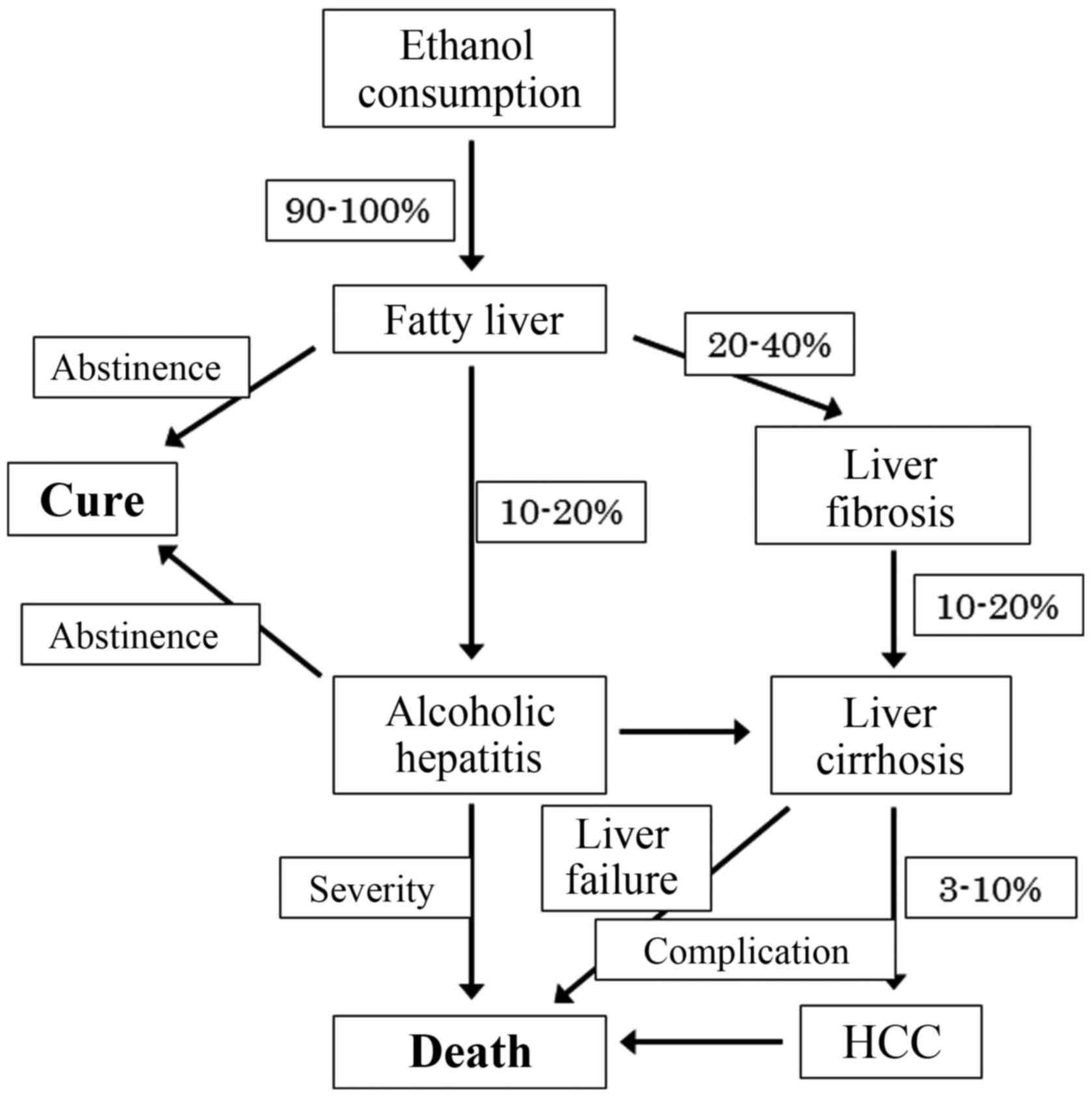 |
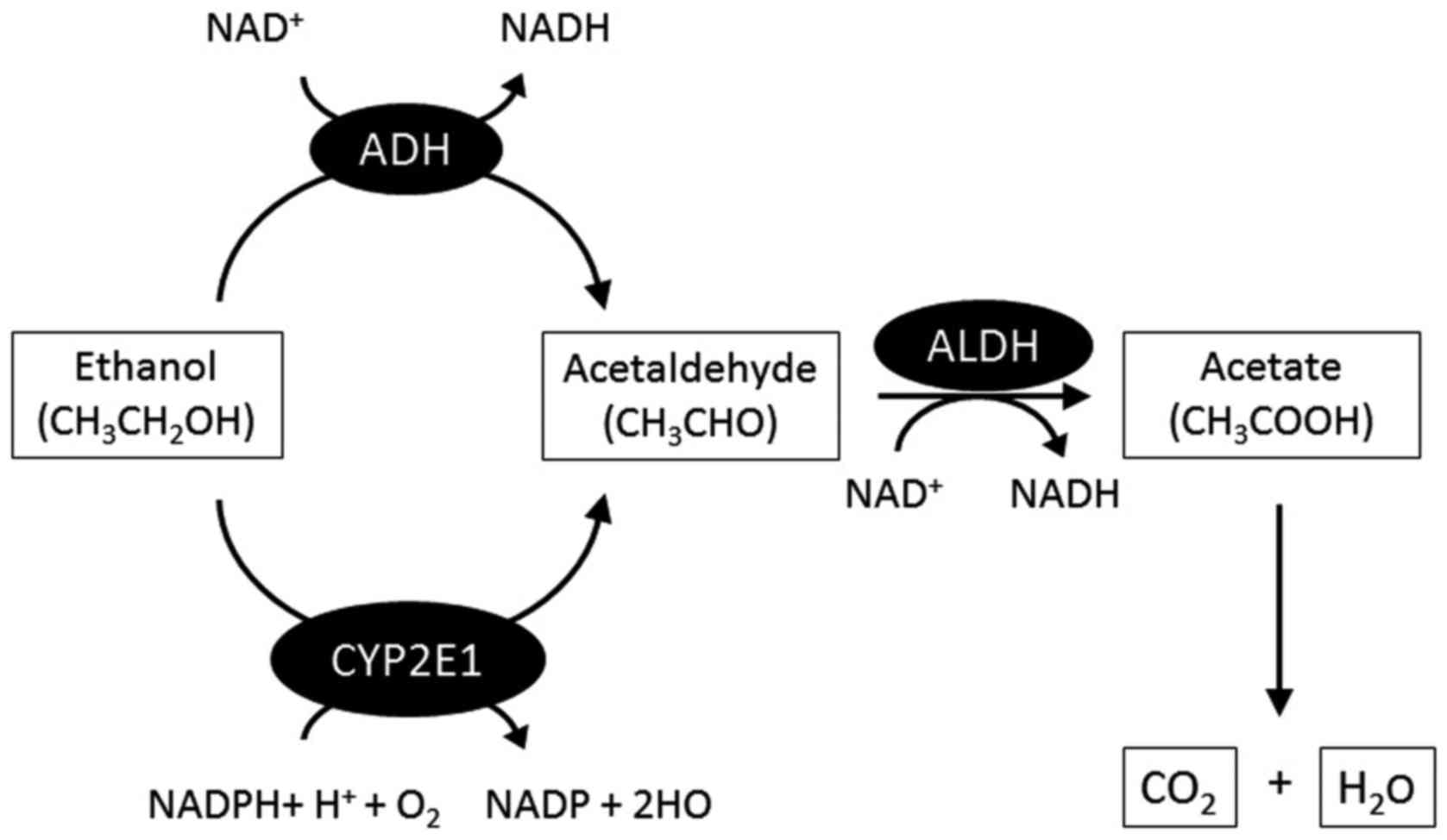 |
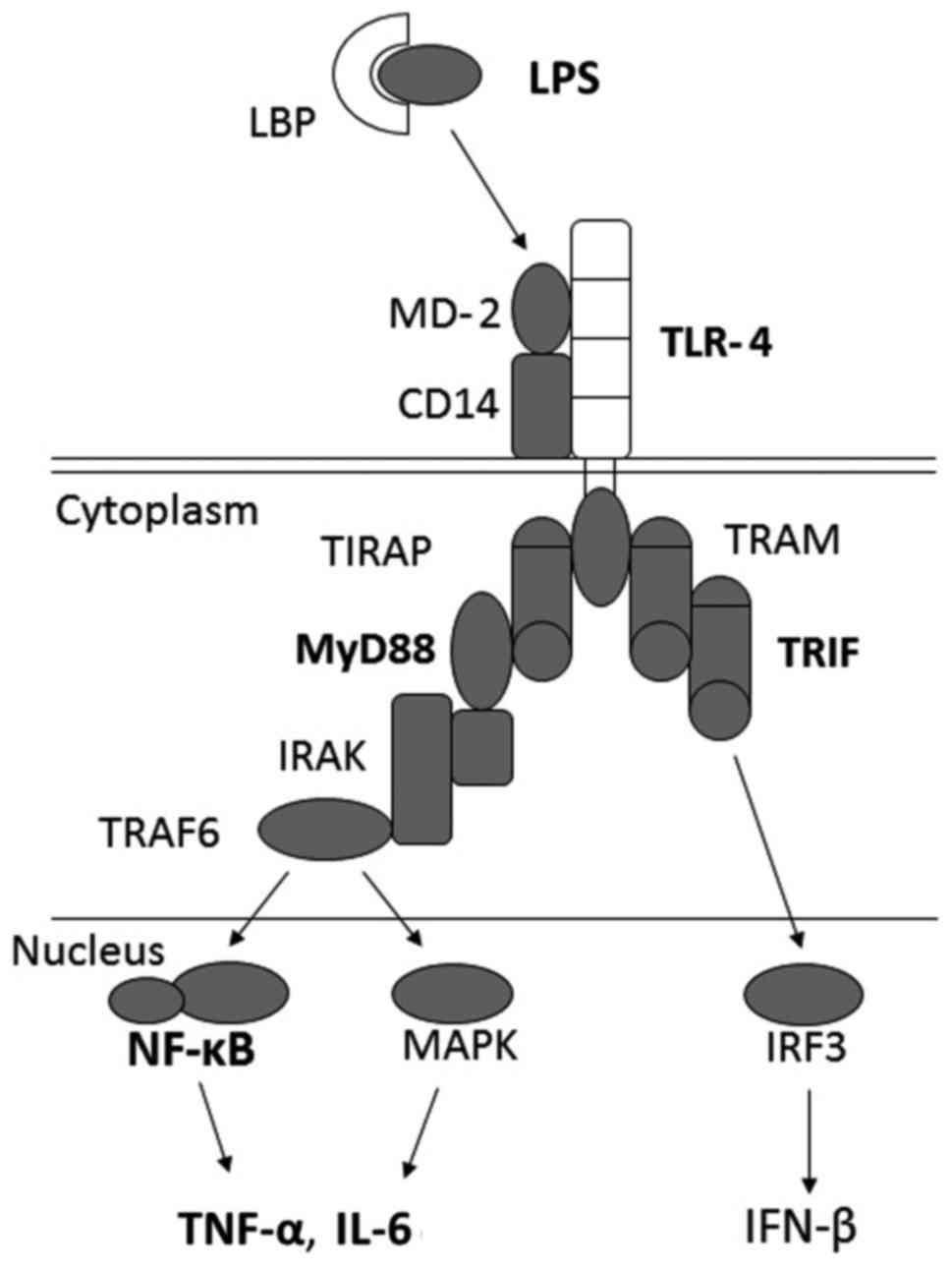 |
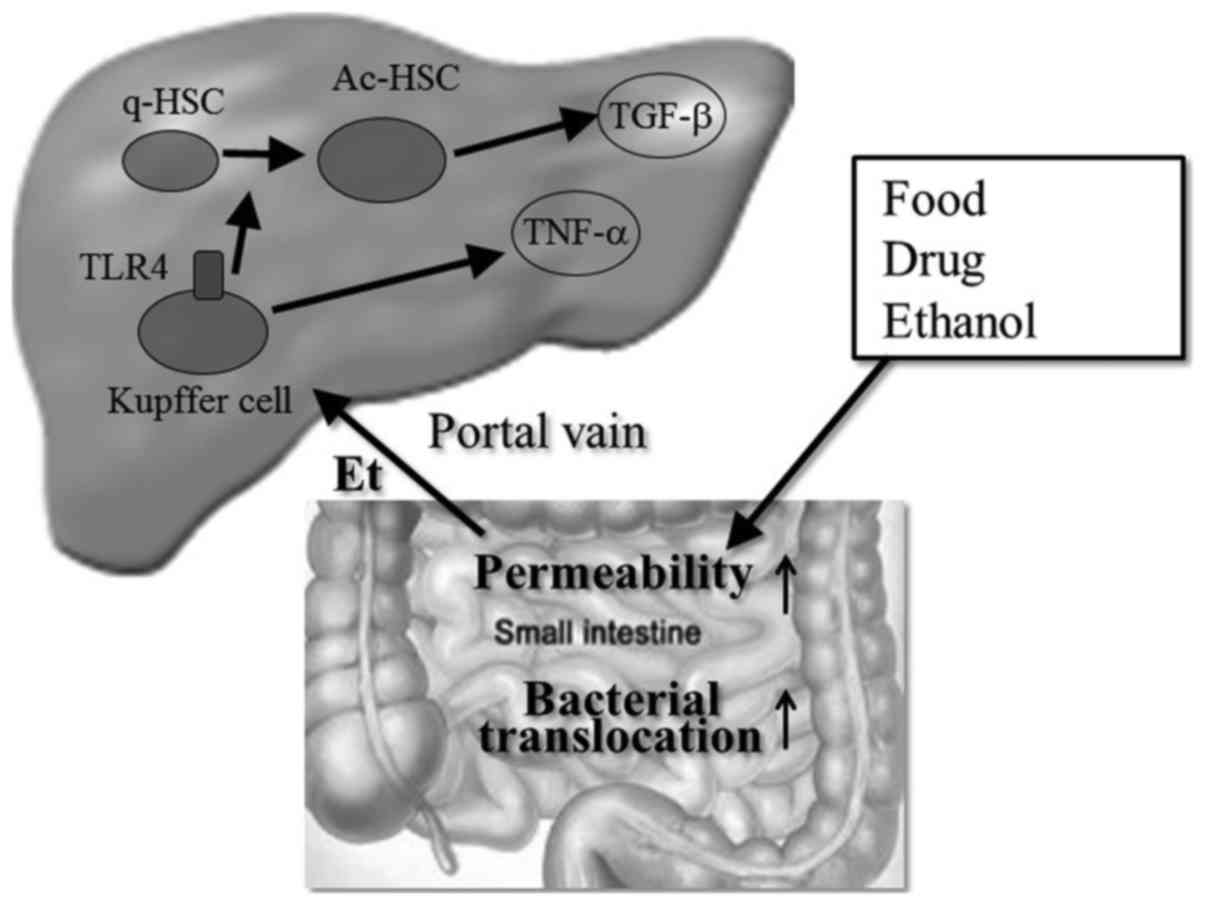 |
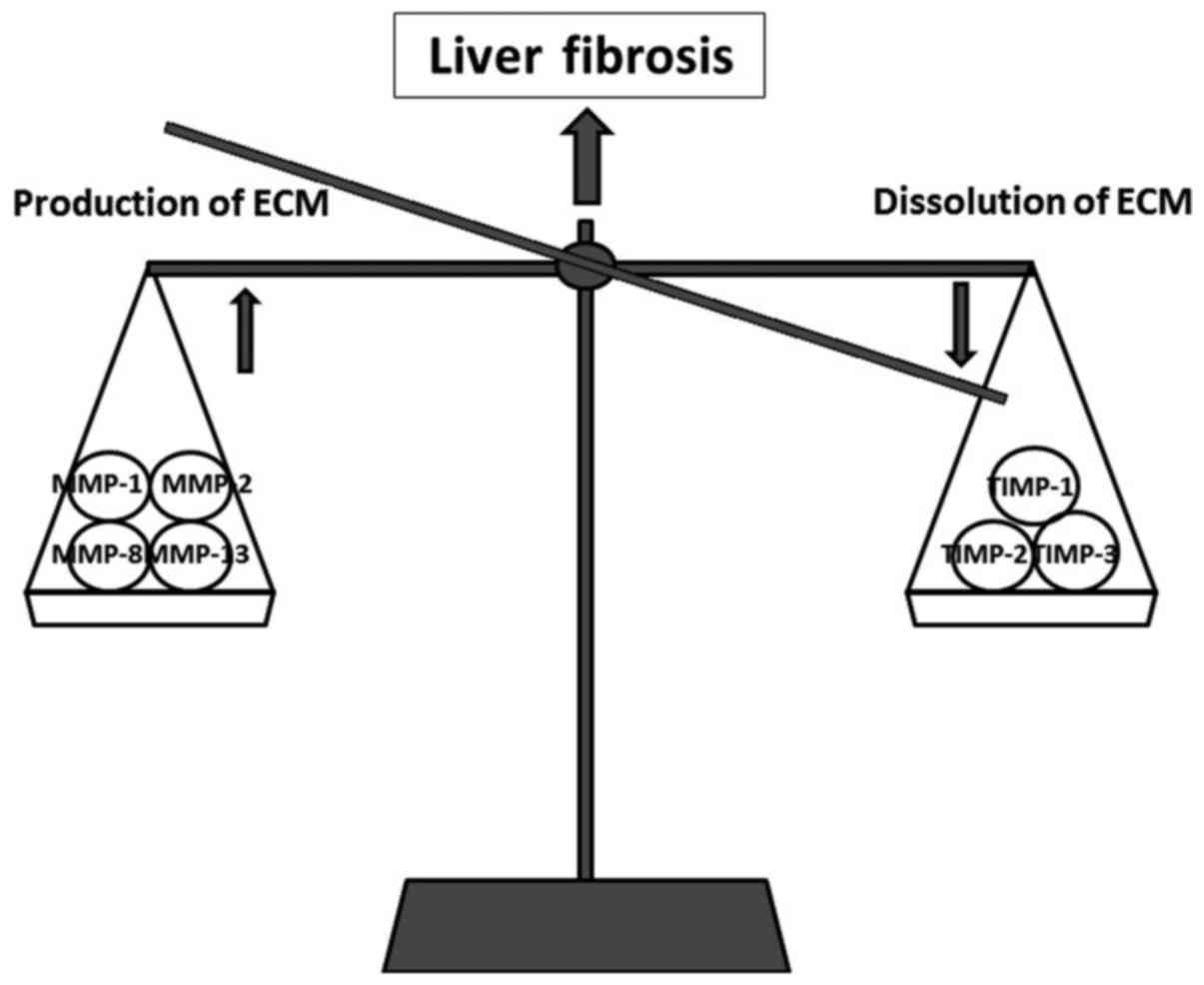 |
|
Teli MR, Day CP, Burt AD, Bennett MK and James OF: Determinants of progression to cirrhosis or fibrosis in pure alcoholic fatty liver. Lancet. 346:987–990. 1995. View Article : Google Scholar : PubMed/NCBI | |
|
Lefkowitch JH: Morphology of alcoholic liver disease. Clin Liver Dis. 9:37–53. 2005. View Article : Google Scholar : PubMed/NCBI | |
|
Cojocariu CE, Trifan AV, Girleanu I and Stanciu C: Alcoholic liver disease - epidemiology and risk factors. Rev Med Chir Soc Med Nat Iasi. 118:910–917. 2014. | |
|
Stickel F: Alcoholic cirrhosis and hepatocellular carcinoma. Adv Exp Med Biol. 815:113–130. 2015. View Article : Google Scholar | |
|
Browning JD and Horton JD: Molecular mediators of hepatic steatosis and liver injury. J Clin Invest. 114:147–152. 2004. View Article : Google Scholar : PubMed/NCBI | |
|
MacSween RN and Burt AD: Histologic spectrum of alcoholic liver disease. Semin Liver Dis. 6:221–232. 1986. View Article : Google Scholar : PubMed/NCBI | |
|
Haber PS, Warner R, Seth D, Gorrell MD and McCaughan GW: Pathogenesis and management of alcoholic hepatitis. J Gastroenterol Hepatol. 18:1332–1344. 2003. View Article : Google Scholar : PubMed/NCBI | |
|
Tsujimoto T, Kuriyama S, Yamazaki M, Nakatani Y, Okuda H, Yoshiji H and Fukui H: Augmented hepatocellular carcinoma progression and depressed Kupffer cell activity in rat cirrhotic livers. Int J Oncol. 18:41–47. 2001. | |
|
Kitazawa T, Nakatani Y, Fujimoto M, Tamura N, Uemura M and Fukui H: The production of tumor necrosis factor-alpha by macrophages in rats with acute alcohol loading. Alcohol Clin Exp Res. 27(Suppl 8): 72S–75S. 2003. View Article : Google Scholar : PubMed/NCBI | |
|
Rao RK, Seth A and Sheth P: Recent advances in alcoholic liver disease I. Role of intestinal permeability and endotoxemia in alcoholic liver disease. Am J Physiol Gastrointest Liver Physiol. 286:G881–G884. 2004. View Article : Google Scholar : PubMed/NCBI | |
|
Canbay A, Feldstein AE, Higuchi H, Werneburg N, Grambihler A, Bronk SF and Gores GJ: Kupffer cell engulfment of apoptotic bodies stimulates death ligand and cytokine expression. Hepatology. 38:1188–1198. 2003. View Article : Google Scholar : PubMed/NCBI | |
|
McClain CJ, Song Z, Barve SS, Hill DB and Deaciuc I: Recent advances in alcoholic liver disease. IV. Dysregulated cytokine metabolism in alcoholic liver disease. Am J Physiol Gastrointest Liver Physiol. 287:G497–G502. 2004. View Article : Google Scholar : PubMed/NCBI | |
|
Gao B: Cytokines, STATs and liver disease. Cell Mol Immunol. 2:92–100. 2005.PubMed/NCBI | |
|
Garcin F, Lau You Hin G, Cote J, Radouco-Thomas S, Chawla S and Radouco-Thomas C: Aldehyde dehydrogenase in Drosophila: developmental and functional aspects. Alcohol. 2:85–89. 1985. View Article : Google Scholar : PubMed/NCBI | |
|
Lieber CS and DeCarli LM: The role of the hepatic microsomal ethanol oxidizing system (MEOS) for ethanol metabolism in vivo. J Pharmacol Exp Ther. 181:279–287. 1972.PubMed/NCBI | |
|
Neve EP and Ingelman-Sundberg M: Molecular basis for the transport of cytochrome P450 2E1 to the plasma membrane. J Biol Chem. 275:17130–17135. 2000. View Article : Google Scholar : PubMed/NCBI | |
|
Lieber CS: Metabolic consequences of ethanol. Endocrinologist. 4:127–139. 1994. View Article : Google Scholar | |
|
Bilzer M, Roggel F and Gerbes AL: Role of Kupffer cells in host defense and liver disease. Liver Int. 26:1175–1186. 2006. View Article : Google Scholar : PubMed/NCBI | |
|
Diehl AM: Recent events in alcoholic liver disease V. Effects of ethanol on liver regeneration. Am J Physiol Gastrointest Liver Physiol. 288:G1–G6. 2005. View Article : Google Scholar | |
|
Hansen J, Cherwitz DL and Allen JI: The role of tumor necrosis factor-alpha in acute endotoxin-induced hepatotoxicity in ethanol-fed rats. Hepatology. 20:461–474. 1994. View Article : Google Scholar : PubMed/NCBI | |
|
Aldred A and Nagy LE: Ethanol dissociates hormone-stimulated cAMP production from inhibition of TNF-alpha production in rat Kupffer cells. Am J Physiol. 276:G98–G106. 1999.PubMed/NCBI | |
|
Kawaratani H, Tsujimoto T, Kitazawa T, Kitade M, Yoshiji H, Uemura M and Fukui H: Innate immune reactivity of the liver in rats fed a choline-deficient L-amino-acid-defined diet. World J Gastroenterol. 14:6655–6661. 2008. View Article : Google Scholar : PubMed/NCBI | |
|
Crespo J, Cayon A, Fernandez-Gil P, Hernandez-Guerra M, Mayorga M, Dominguez-Diez A, Fernandez-Escalante JC and Pons-Romero F: Gene expression of tumor necrosis factor alpha and TNF-receptors, p55 and p75, in nonalcoholic steatohepatitis patients. Hepatology. 34:1158–1163. 2001. View Article : Google Scholar : PubMed/NCBI | |
|
Tilg H, Jalan R, Kaser A, Davies NA, Offner FA, Hodges SJ, Ludwiczek O, Shawcross D, Zoller H, Alisa A, et al: Anti-tumor necrosis factor-alpha monoclonal antibody therapy in severe alcoholic hepatitis. J Hepatol. 38:419–425. 2003. View Article : Google Scholar : PubMed/NCBI | |
|
Akriviadis E, Botla R, Briggs W, Han S, Reynolds T and Shakil O: Pentoxifylline improves short-term survival in severe acute alcoholic hepatitis: a double-blind, placebo-controlled trial. Gastroenterology. 119:1637–1648. 2000. View Article : Google Scholar : PubMed/NCBI | |
|
Iimuro Y, Gallucci RM, Luster MI, Kono H and Thurman RG: Antibodies to tumor necrosis factor alfa attenuate hepatic necrosis and inflammation caused by chronic exposure to ethanol in the rat. Hepatology. 26:1530–1537. 1997. View Article : Google Scholar : PubMed/NCBI | |
|
Kawaratani H, Tsujimoto T, Kitazawa T, Yoshiji H, Uemura M and Fukui H: Therapeutic effects of cytokine modulator Y-40138 in the rat alcoholic liver disease model. J Gastroenterol Hepatol. 26:775–783. 2011. View Article : Google Scholar : PubMed/NCBI | |
|
Hong F, Kim WH, Tian Z, Jaruga B, Ishac E, Shen X and Gao B: Elevated interleukin-6 during ethanol consumption acts as a potential endogenous protective cytokine against ethanol-induced apoptosis in the liver: involvement of induction of Bcl-2 and Bcl-x(L) proteins. Oncogene. 21:32–43. 2002. View Article : Google Scholar : PubMed/NCBI | |
|
Mathurin P, Deng QG, Keshavarzian A, Choudhary S, Holmes EW and Tsukamoto H: Exacerbation of alcoholic liver injury by enteral endotoxin in rats. Hepatology. 32:1008–1017. 2000. View Article : Google Scholar : PubMed/NCBI | |
|
Hawrylowicz CM and O'Garra A: Potential role of interleukin-10-secreting regulatory T cells in allergy and asthma. Nat Rev Immunol. 5:271–283. 2005. View Article : Google Scholar : PubMed/NCBI | |
|
Louis H, Le Moine O, Goldman M and Deviere J: Modulation of liver injury by interleukin-10. Acta Gastroenterol Belg. 66:7–14. 2003.PubMed/NCBI | |
|
Latvala J, Hietala J, Koivisto H, Jarvi K, Anttila P and Niemela O: Immune responses to ethanol metabolites and cytokine profiles differentiate alcoholics with or without liver disease. Am J Gastroenterol. 100:1303–1310. 2005. View Article : Google Scholar : PubMed/NCBI | |
|
Zhang X, Tachibana S, Wang H, Hisada M, Williams GM, Gao B and Sun Z: Interleukin-6 is an important mediator for mitochondrial DNA repair after alcoholic liver injury in mice. Hepatology. 52:2137–2147. 2010. View Article : Google Scholar : PubMed/NCBI | |
|
Rabe B, Chalaris A, May U, Waetzig GH, Seegert D, Williams AS, Jones SA, Rose-John S and Scheller J: Transgenic blockade of interleukin 6 transsignaling abrogates inflammation. Blood. 111:1021–1028. 2008. View Article : Google Scholar | |
|
Miller AM, Wang H, Bertola A, Park O, Horiguchi N, Ki SH, Yin S, Lafdil F and Gao B: Inflammation-associated interleukin-6/signal transducer and activator of transcription 3 activation ameliorates alcoholic and nonalcoholic fatty liver diseases in interleukin-10-deficient mice. Hepatology. 54:846–856. 2011. View Article : Google Scholar : PubMed/NCBI | |
|
Jura J, Wegrzyn P, Korostyński M, Guzik K, Oczko- Wojciechowska M, Jarzab M, Kowalska M, Piechota M, Przewłocki R and Koj A: Identification of interleukin-1 and interleukin-6-responsive genes in human monocyte-derived macrophages using microarrays. Biochim Biophys Acta. 1779:383–389. 2008. View Article : Google Scholar : PubMed/NCBI | |
|
Acosta-Rodriguez EV, Napolitani G, Lanzavecchia A and Sallusto F: Interleukins 1beta and 6 but not transforming growth factor-beta are essential for the differentiation of interleukin 17-producing human T helper cells. Nat Immunol. 8:942–949. 2007. View Article : Google Scholar : PubMed/NCBI | |
|
Weaver CT, Hatton RD, Mangan PR and Harrington LE: IL-17 family cytokines and the expanding diversity of effector T cell lineages. Annu Rev Immunol. 25:821–852. 2007. View Article : Google Scholar : PubMed/NCBI | |
|
Lafdil F, Miller AM, Ki SH and Gao B: Th17 cells and their associated cytokines in liver diseases. Cell Mol Immunol. 7:250–254. 2010. View Article : Google Scholar : PubMed/NCBI | |
|
Lemmers A, Moreno C, Gustot T, Marechal R, Degre D, Demetter P, de Nadai P, Geerts A, Quertinmont E, Vercruysse V, et al: The interleukin-17 pathway is involved in human alcoholic liver disease. Hepatology. 49:646–657. 2009. View Article : Google Scholar : PubMed/NCBI | |
|
Nanji AA, Zhao S, Sadrzadeh SM, Dannenberg AJ, Tahan SR and Waxman DJ: Markedly enhanced cytochrome P450 2E1 induction and lipid peroxidation is associated with severe liver injury in fish oil-ethanol-fed rats. Alcohol Clin Exp Res. 18:1280–1285. 1994. View Article : Google Scholar : PubMed/NCBI | |
|
Ki SH, Park O, Zheng M, Morales-Ibanez O, Kolls JK, Bataller R and Gao B: Interleukin-22 treatment ameliorates alcoholic liver injury in a murine model of chronic-binge ethanol feeding: role of signal transducer and activator of transcription 3. Hepatology. 52:1291–1300. 2010. View Article : Google Scholar : PubMed/NCBI | |
|
Dominguez M, Miquel R, Colmenero J, Moreno M, Garcia-Pagan JC, Bosch J, Arroyo V, Gines P, Caballeria J and Bataller R: Hepatic expression of CXC chemokines predicts portal hypertension and survival in patients with alcoholic hepatitis. Gastroenterology. 136:1639–1650. 2009. View Article : Google Scholar : PubMed/NCBI | |
|
Simpson KJ, Henderson NC, Bone-Larson CL, Lukacs NW, Hogaboam CM and Kunkel SL: Chemokines in the pathogenesis of liver disease: so many players with poorly defined roles. Clin Sci (Lond). 104:47–63. 2003. View Article : Google Scholar | |
|
Jiang Y, Beller DI, Frendl G and Graves DT: Monocyte chemoattractant protein-1 regulates adhesion molecule expression and cytokine production in human monocytes. J Immunol. 148:2423–2428. 1992.PubMed/NCBI | |
|
Fisher NC, Neil DA, Williams A and Adams DH: Serum concentrations and peripheral secretion of the beta chemokines monocyte chemoattractant protein 1 and macrophage inflammatory protein 1alpha in alcoholic liver disease. Gut. 45:416–420. 1999. View Article : Google Scholar : PubMed/NCBI | |
|
Lu B, Rutledge BJ, Gu L, Fiorillo J, Lukacs NW, Kunkel SL, North R, Gerard C and Rollins BJ: Abnormalities in monocyte recruitment and cytokine expression in monocyte chemoattractant protein 1-deficient mice. J Exp Med. 187:601–608. 1998. View Article : Google Scholar : PubMed/NCBI | |
|
Mandrekar P, Ambade A, Lim A, Szabo G and Catalano D: An essential role for monocyte chemoattractant protein-1 in alcoholic liver injury: regulation of proinflammatory cytokines and hepatic steatosis in mice. Hepatology. 54:2185–2197. 2011. View Article : Google Scholar : PubMed/NCBI | |
|
Sahin H and Wasmuth HE: Chemokines in tissue fibrosis. Biochim Biophys Acta. 1832:1041–1048. 2013. View Article : Google Scholar | |
|
Strieter RM, Burdick MD, Gomperts BN, Belperio JA and Keane MP: CXC chemokines in angiogenesis. Cytokine Growth Factor Rev. 16:593–609. 2005. View Article : Google Scholar : PubMed/NCBI | |
|
Alfonso-Loeches S, Ureña-Peralta JR, Morillo-Bargues MJ, Oliver-De La Cruz J and Guerri C: Role of mitochondria ROS generation in ethanol-induced NLRP3 inflammasome activation and cell death in astroglial cells. Front Cell Neurosci. 8:2162014. View Article : Google Scholar : PubMed/NCBI | |
|
Szabo G and Csak T: Inflammasomes in liver diseases. J Hepatol. 57:642–654. 2012. View Article : Google Scholar : PubMed/NCBI | |
|
Petrasek J, Iracheta-Vellve A, Saha B, Satishchandran A, Kodys K, Fitzgerald KA, Kurt-Jones EA and Szabo G: Metabolic danger signals, uric acid and ATP, mediate inflammatory cross-talk between hepatocytes and immune cells in alcoholic liver disease. J Leukoc Biol. 98:249–256. 2015. View Article : Google Scholar : PubMed/NCBI | |
|
Petrasek J, Bala S, Csak T, Lippai D, Kodys K, Menashy V, Barrieau M, Min SY, Kurt-Jones EA and Szabo G: IL-1 receptor antagonist ameliorates inflammasome-dependent alcoholic steatohepatitis in mice. J Clin Invest. 122:3476–3489. 2012. View Article : Google Scholar : PubMed/NCBI | |
|
Zhang Q, Raoof M, Chen Y, Sumi Y, Sursal T, Junger W, Brohi K, Itagaki K and Hauser CJ: Circulating mitochondrial DAMPs cause inflammatory responses to injury. Nature. 464:104–107. 2010. View Article : Google Scholar : PubMed/NCBI | |
|
Akira S, Uematsu S and Takeuchi O: Pathogen recognition and innate immunity. Cell. 124:783–801. 2006. View Article : Google Scholar : PubMed/NCBI | |
|
Medzhitov R, Preston-Hurlburt P and Janeway CA Jr: A human homologue of the Drosophila Toll protein signals activation of adaptive immunity. Nature. 388:394–397. 1997. View Article : Google Scholar : PubMed/NCBI | |
|
Yamamoto M, Sato S, Hemmi H, Hoshino K, Kaisho T, Sanjo H, Takeuchi O, Sugiyama M, Okabe M, Takeda K, et al: Role of adaptor TRIF in the MyD88-independent toll-like receptor signaling pathway. Science. 301:640–643. 2003. View Article : Google Scholar : PubMed/NCBI | |
|
Petrasek J, Mandrekar P and Szabo G: Toll-like receptors in the pathogenesis of alcoholic liver disease. Gastroenterol Res Pract. 2010:7103812010. View Article : Google Scholar : PubMed/NCBI | |
|
Szabo G, Mandrekar P, Petrasek J and Catalano D: The unfolding web of innate immune dysregulation in alcoholic liver injury. Alcohol Clin Exp Res. 35:782–786. 2011. View Article : Google Scholar : PubMed/NCBI | |
|
Yin M, Bradford BU, Wheeler MD, Uesugi T, Froh M, Goyert SM and Thurman RG: Reduced early alcohol-induced liver injury in CD14-deficient mice. J Immunol. 166:4737–4742. 2001. View Article : Google Scholar : PubMed/NCBI | |
|
Paik YH, Schwabe RF, Bataller R, Russo MP, Jobin C and Brenner DA: Toll-like receptor 4 mediates inflammatory signaling by bacterial lipopolysaccharide in human hepatic stellate cells. Hepatology. 37:1043–1055. 2003. View Article : Google Scholar : PubMed/NCBI | |
|
Fujimoto M, Uemura M, Nakatani Y, Tsujita S, Hoppo K, Tamagawa T, Kitano H, Kikukawa M, Ann T, Ishii Y, et al: Plasma endotoxin and serum cytokine levels in patients with alcoholic hepatitis: relation to severity of liver disturbance. Alcohol Clin Exp Res. 24(Suppl 4): 48S–54S. 2000.PubMed/NCBI | |
|
Fukui H, Brauner B, Bode JC and Bode C: Plasma endotoxin concentrations in patients with alcoholic and non-alcoholic liver disease: reevaluation with an improved chromogenic assay. J Hepatol. 12:162–169. 1991. View Article : Google Scholar : PubMed/NCBI | |
|
Gustot T, Lemmers A, Moreno C, Nagy N, Quertinmont E, Nicaise C, Franchimont D, Louis H, Devière J and Le Moine O: Differential liver sensitization to toll-like receptor pathways in mice with alcoholic fatty liver. Hepatology. 43:989–1000. 2006. View Article : Google Scholar : PubMed/NCBI | |
|
Mandrekar P, Catalano D, White B and Szabo G: Moderate alcohol intake in humans attenuates monocyte inflammatory responses: inhibition of nuclear regulatory factor kappa B and induction of interleukin 10. Alcohol Clin Exp Res. 30:135–139. 2006. View Article : Google Scholar : PubMed/NCBI | |
|
Hartmann P, Seebauer CT and Schnabl B: Alcoholic liver disease: the gut microbiome and liver cross talk. Alcohol Clin Exp Res. 39:763–775. 2015. View Article : Google Scholar : PubMed/NCBI | |
|
Keshavarzian A, Holmes EW, Patel M, Iber F, Fields JZ and Pethkar S: Leaky gut in alcoholic cirrhosis: a possible mechanism for alcohol-induced liver damage. Am J Gastroenterol. 94:200–207. 1999. View Article : Google Scholar : PubMed/NCBI | |
|
Bala S, Marcos M, Kodys K, Csak T, Catalano D, Mandrekar P and Szabo G: Up-regulation of microRNA-155 in macrophages contributes to increased tumor necrosis factor α (TNFα) production via increased mRNA half-life in alcoholic liver disease. J Biol Chem. 286:1436–1444. 2011. View Article : Google Scholar | |
|
Kavanaugh MJ, Clark C, Goto M, Kovacs EJ, Gamelli RL, Sayeed MM and Choudhry MA: Effect of acute alcohol ingestion prior to burn injury on intestinal bacterial growth and barrier function. Burns. 31:290–296. 2005. View Article : Google Scholar : PubMed/NCBI | |
|
Thakur V, McMullen MR, Pritchard MT and Nagy LE: Regulation of macrophage activation in alcoholic liver disease. J Gastroenterol Hepatol. 22(Suppl 1): S53–S56. 2007. View Article : Google Scholar : PubMed/NCBI | |
|
Rao R: Endotoxemia and gut barrier dysfunction in alcoholic liver disease. Hepatology. 50:638–644. 2009. View Article : Google Scholar : PubMed/NCBI | |
|
Yan AW, Fouts DE, Brandl J, Stärkel P, Torralba M, Schott E, Tsukamoto H, Nelson KE, Brenner DA and Schnabl B: Enteric dysbiosis associated with a mouse model of alcoholic liver disease. Hepatology. 53:96–105. 2011. View Article : Google Scholar : PubMed/NCBI | |
|
Bull-Otterson L, Feng W, Kirpich I, Wang Y, Qin X, Liu Y, Gobejishvili L, Joshi-Barve S, Ayvaz T, Petrosino J, et al: Meta-genomic analyses of alcohol induced pathogenic alterations in the intestinal microbiome and the effect of Lactobacillus rhamnosus GG treatment. PLoS One. 8:e530282013. View Article : Google Scholar | |
|
Forsyth CB, Farhadi A, Jakate SM, Tang Y, Shaikh M and Keshavarzian A: Lactobacillus GG treatment ameliorates alcohol-induced intestinal oxidative stress, gut leakiness, and liver injury in a rat model of alcoholic steatohepatitis. Alcohol. 43:163–172. 2009. View Article : Google Scholar : PubMed/NCBI | |
|
Gratz SW, Mykkanen H and El-Nezami HS: Probiotics and gut health: a special focus on liver diseases. World J Gastroenterol. 16:403–410. 2010. View Article : Google Scholar : PubMed/NCBI | |
|
Choudhry MA, Fazal N, Goto M, Gamelli RL and Sayeed MM: Gut-associated lymphoid T cell suppression enhances bacterial translocation in alcohol and burn injury. Am J Physiol Gastrointest Liver Physiol. 282:G937–G947. 2002. View Article : Google Scholar : PubMed/NCBI | |
|
Szabo G and Bala S: Alcoholic liver disease and the gut-liver axis. World J Gastroenterol. 16:1321–1329. 2010. View Article : Google Scholar : PubMed/NCBI | |
|
Hoek JB and Pastorino JG: Ethanol, oxidative stress, and cytokine-induced liver cell injury. Alcohol. 27:63–68. 2002. View Article : Google Scholar : PubMed/NCBI | |
|
Adachi Y, Moore LE, Bradford BU, Gao W and Thurman RG: Antibiotics prevent liver injury in rats following long-term exposure to ethanol. Gastroenterology. 108:218–224. 1995. View Article : Google Scholar : PubMed/NCBI | |
|
Semenza GL: Hypoxia-inducible factors in physiology and medicine. Cell. 148:399–408. 2012. View Article : Google Scholar : PubMed/NCBI | |
|
Carmeliet P and Jain RK: Molecular mechanisms and clinical applications of angiogenesis. Nature. 473:298–307. 2011. View Article : Google Scholar : PubMed/NCBI | |
|
Nath B and Szabo G: Alcohol-induced modulation of signaling pathways in liver parenchymal and nonparenchymal cells: implications for immunity. Semin Liver Dis. 29:166–177. 2009. View Article : Google Scholar : PubMed/NCBI | |
|
Valfrè di Bonzo L, Novo E, Cannito S, Busletta C, Paternostro C, Povero D and Parola M: Angiogenesis and liver fibrogenesis. Histol Histopathol. 24:1323–1341. 2009.PubMed/NCBI | |
|
Novo E, Povero D, Busletta C, Paternostro C, di Bonzo LV, Cannito S, Compagnone A, Bandino A, Marra F, Colombatto S, et al: The biphasic nature of hypoxia-induced directional migration of activated human hepatic stellate cells. J Pathol. 226:588–597. 2012. View Article : Google Scholar | |
|
Ciupińska-Kajor M, Hartleb M, Kajor M, Kukla M, Wyleżoł M, Lange D and Liszka L: Hepatic angiogenesis and fibrosis are common features in morbidly obese patients. Hepatol Int. 7:233–240. 2013. View Article : Google Scholar | |
|
Sanz-Cameno P, Trapero-Marugán M, Chaparro M, Jones EA and Moreno-Otero R: Angiogenesis: from chronic liver inflammation to hepatocellular carcinoma. J Oncol. 2010:2721702010. View Article : Google Scholar : PubMed/NCBI | |
|
Marra F and Tacke F: Roles for chemokines in liver disease. Gastroenterology. 147:577–594.e1. 2014. View Article : Google Scholar : PubMed/NCBI | |
|
Raskopf E, Gonzalez Carmona MA, Van Cayzeele CJ, Strassburg C, Sauerbruch T and Schmitz V: Toxic damage increases angiogenesis and metastasis in fibrotic livers via PECAM-1. Biomed Res Int. 2014:7128932014. View Article : Google Scholar : | |
|
Svegliati-Baroni G, Ridolfi F, Di Sario A, Saccomanno S, Bendia E, Benedetti A and Greenwel P: Intracellular signaling pathways involved in acetaldehyde-induced collagen and fibronectin gene expression in human hepatic stellate cells. Hepatology. 33:1130–1140. 2001. View Article : Google Scholar : PubMed/NCBI | |
|
Das SK and Vasudevan DM: Genesis of hepatic fibrosis and its biochemical markers. Scand J Clin Lab Invest. 68:260–269. 2008. View Article : Google Scholar : PubMed/NCBI | |
|
Gao B and Bataller R: Alcoholic liver disease: pathogenesis and new therapeutic targets. Gastroenterology. 141:1572–1585. 2011. View Article : Google Scholar : PubMed/NCBI | |
|
Nanji AA, Khettry U and Sadrzadeh SM: Lactobacillus feeding reduces endotoxemia and severity of experimental alcoholic liver (disease). Proc Soc Exp Biol Med. 205:243–247. 1994. View Article : Google Scholar : PubMed/NCBI | |
|
Bass NM, Mullen KD, Sanyal A, Poordad F, Neff G, Leevy CB, Sigal S, Sheikh MY, Beavers K, Frederick T, et al: Rifaximin treatment in hepatic encephalopathy. N Engl J Med. 362:1071–1081. 2010. View Article : Google Scholar : PubMed/NCBI | |
|
Mencin A, Kluwe J and Schwabe RF: Toll-like receptors as targets in chronic liver diseases. Gut. 58:704–720. 2009. View Article : Google Scholar : PubMed/NCBI |










